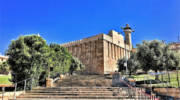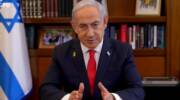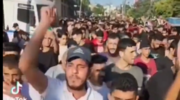Mistakenly confused with Sukkot and sometimes referred to as the last days of Sukkot, the holiday of Simchat Torah is actually an independent holiday that begins the moment the holiday of Sukkot ends.
By Rabbi Ari Enkin, Rabbinic Director, United with Israel
Formally known as Shemini Atzeret, Simchat Torah is the day on which we read the last few chapters of the Torah thereby completing it.
The Torah is then begun anew from the beginning, with the reading of the story of Creation.
As the completion of the reading of the Torah is the conclusion of a year of reading and studying, the day is very festive in nature. That means lots and lots of dancing, and if you’re in the “right” synagogue, you might even get something special to drink, as well.
As is widely known, the Torah concludes with the death of Moses. For reasons the commentators can only guess, Moses’ burial site was hidden from us. God does not want us to know where he is buried. All we know is that he is buried somewhere on Mount Nebo. (Deuteronomy 34:6)
In fact, the Talmud tells us that people have made all kinds of attempts to locate the exact place of Moses’ burial but have never been successful due to Divine intervention.
Is it a problem of some sort that we do not know where the greatest rabbi in history is buried? Should this upset us?
It is explained that it is not always necessary to know where a person is buried. God was worried that if the world knew where Moses was buried his grave would become a shrine and site of extreme pilgrimage and possibly even a site of idol worship. Indeed, it is forbidden to pray to the dead when we visit their graves, no matter how holy they were.
In fact, according to most authorities it is even forbidden to address the dead in any way. Rather, when visiting graves we are to pray to God asking that He answer our prayers in the merit of the person buried there. In the case of Moses, God was worried that people might end up praying to him directly. This is one reason the grave of Moses was hidden.
Another reason offered as to why Moses’ burial place was hidden was in order to ensure that Joshua would be given the respect and allegiance he deserved. If Moses’ burial place were known, the Jewish people may have never accepted Joshua as their new leader, preferring to remain connected to Moses through his grave. Hiding the grave site helped ensure that the people would follow Joshua into the Promised Land.
This latter explanation is very important and relevant to us. No, there will never be another Moses; he will always be the greatest spiritual leader that ever lived. But we have to learn to follow the leaders that we do have. Indeed, in several places the Torah tells us that we must accept the leaders in every time and place and give them the respect and allegiance that they deserve. (See Deut 17:9 and 26:3, for example.)
The fact that the current leader is no Moses doesn’t make a difference. As it says in Ecclesiastes, “A generation passes on and a new generation comes.” (1:4) We have to accept the leaders that we have. This is what the Torah is telling us.

Do You Love Israel? Make a Donation - Show Your Support!
Donate to vital charities that help protect Israeli citizens and inspire millions around the world to support Israel too!
Now more than ever, Israel needs your help to fight and win the war -- including on the battlefield of public opinion.
Antisemitism, anti-Israel bias and boycotts are out of control. Israel's enemies are inciting terror and violence against innocent Israelis and Jews around the world. Help us fight back!























